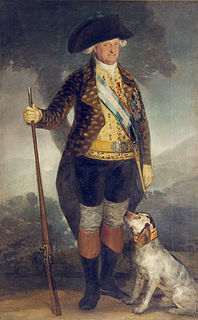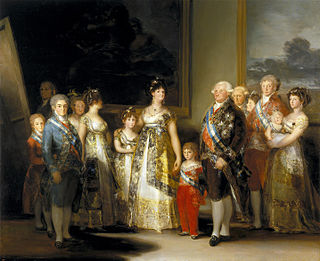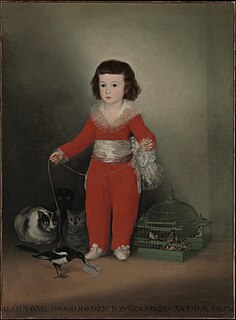 W
WBernardo de Iriarte is a 1797 portrait painting by the Spanish artist Francisco Goya. It is on display in the Musée des Beaux-Arts of Strasbourg, France. Its inventory number is 1660.
 W
WCharles IV in his Hunting Clothes is an oil on canvas painting of 1799 by the Spanish artist Francisco Goya, the second of his two portraits of King Charles IV of Spain. Goya had earlier been court painter to Charles III, who was widely viewed as the more astute political operator of the pair. While not lacking intelligence, Carlos IV is broadly seen as an idler compared to his father; ultimately he was outmaneuvered by Napoleon at a time when he was more interested in sport and hunting than affairs of state.
 W
WCharles IV of Spain and His Family is an oil-on-canvas painting by the Spanish artist Francisco Goya. He began work on the painting in 1800, shortly after he became First Chamber Painter to the royal family, and completed it in the summer of 1801.
 W
WPortrait of Charles IV of Spain is a portrait of Charles IV of Spain in hunting dress with a hunting dog. Both it and a pendant of his wife were long thought to be a copy after an autograph work by Francisco Goya, but they have now been definitively reattributed as autograph works by Goya himself, produced late in the 18th century. Goya was a court artist to the royal family, though most of his paintings of them are still in the Prado Museum. The two works were commissioned by Charles's daughter Maria Isabella of Spain along with. It was sent to Maria Isabella and they are both now in the National Museum of Capodimonte in Naples.
 W
WThe Countess of Chinchon was painted by Francisco Goya about 1800. It is held in the Museo del Prado, Madrid. The painting depicts María Teresa de Borbón, 15th Countess of Chinchón, who had been encouraged by Queen Maria Luisa of Parma and by opportunism to marry Manuel de Godoy, the Prime Minister, in a marriage of convenience. It does not depict the more famous Countess of Chinchón who became the namesake of the cinchona genus of trees and shrubs responsible for early modern quinine production.
 W
WThe Duchess of Alba and "la Beata" is a small 1795 oil on canvas painting by the Spanish artist Francisco Goya.
 W
WThe Portrait of the Duke of Wellington is a painting by the Spanish artist Francisco Goya of the British general Arthur Wellesley, 1st Duke of Wellington during the latter's service in the Peninsular War. One of three portraits Goya painted of Wellington, it was begun in August 1812, after the subject's entry into Madrid, showing him as an earl in red uniform and wearing the Peninsular Medal. The artist then modified it in 1814 to show him in full dress black uniform with gold braid and to add the Order of the Golden Fleece and Military Gold Cross with three clasps.
 W
WThe Family of the Infante Don Luis is a 1783-1784 painting by Francisco Goya, now in the Fondazione Magnani-Rocca in Parma. Goya was invited to the Arenas de San Pedro estate near Ávila in mid August 1783 by Charles III's brother Luis of Spain, the portrait's subject along with his wife María Teresa de Vallebriga and their children.
 W
WPortrait of Manuel Godoy is a large 1801 oil on canvas painting by the Spanish artist Francisco de Goya, now in the Real Academia de Bellas Artes de San Fernando. It was commissioned by the Spanish Prime Minister Manuel Godoy to commemorate his victory in the brief War of the Oranges against Portugal.
 W
WPortrait of Ferdinand Guillemardet is a 1798–99 painting by Francisco Goya, now in the Louvre.
 W
WLa Leocadia or The Seductress are names given to a mural by the Spanish artist Francisco Goya, completed sometime between 1819–1823, as one of his series of 14 Black Paintings. It shows a woman commonly identified as Goya's maid, companion and lover, Leocadia Weiss. She is dressed in a dark, almost funeral maja dress, and leans against what is either a mantelpiece or burial mound, as she looks outward at the viewer with a sorrowful expression. Leocadia is one of the final of the Black Paintings, which he painted in his seventies at a time when he was consumed by political, physical and psychological turmoil, after he fled to the country from his position as court painter in Madrid.
 W
WManuel Osorio Manrique de Zúñiga is a large full-length portrait in oil painted in 1787–88 by the Spanish artist Francisco Goya. It depicts a boy three or four years of age, standing in red clothes, with birds and cats. It is also known as Goya's "Red Boy". It was described by art historian Claus Virch in 1967 as "one of the most appealing and successful portraits of children ever painted, and also one of the most famous". The painting has been held by the Metropolitan Museum of Art in New York since 1949.
 W
WThe Portrait of the Marchioness of Santa Cruz or Portrait of the Marquise of Santa Cruz is an 1805 portrait by the Spanish artist Francisco José de Goya y Lucientes, a family friend of the subject. It has been owned by the Museo del Prado since 1986, when it bought it from its previous owner for over US$6 million.
 W
WPortrait of Maria Luisa of Parma is a portrait of Maria Luisa of Parma, wife of Charles IV of Spain, produced as a pendant painting to a portrait of her husband. Both works were long thought to be a copy after an autograph work by Francisco Goya, but they have now been definitively reattributed as autograph works by Goya himself, produced late in the 18th century. Goya was a court artist to the royal family, though most of his paintings of them are still in the Prado Museum. The two works were commissioned by the couple's daughter Maria Isabella of Spain. They were sent to Maria Isabella and they are both now in the National Museum of Capodimonte in Naples.
 W
WPortrait of the Marquise de la Solana is a 1795 full length portrait by Francisco Goya of his friend the Marquise de la Solana. It now hangs in the Louvre in Paris, to which it was given in 1953 by Carlos de Beistegui.
 W
WThe Portrait of Doña Isabel de Porcel is an oil-on-canvas painting by Spanish painter Francisco Goya around 1805. The portrait depicts Isabel Lobo Velasco de Porcel, who was born at Ronda around 1780 and was the second wife of Antonio Porcel. Isabel's husband was 25 years older than she; they met when she was 20 years old. Antonio Porcel was a liberal and associate of Manuel Godoy, Prince of Peace, who was a friend of Gaspar Melchor de Jovellanos, who in turn brought him in contact with Goya, who lived nearby; the painting is said to have been a gift from the artist in return for hospitality. A Goya portrait of Antonio Porcel, though much larger and so not a matching piece, was lost in a fire when the Jockey Club in Buenos Aires was destroyed in a riot in 1953.
 W
WPortrait of Don Ramón Satué is an 1823 oil on panel painting by the Spanish artist Francisco de Goya in the collection of the Rijksmuseum. It is the only publicly held Goya in the Netherlands.
 W
WSelf-portrait at an Easel or Self-portrait in the Studio is a 1790-1795 cabinet-format portrait by Francisco de Goya, now in the Real Academia de Bellas Artes de San Fernando.
 W
WSelf-Portrait with Dr Arrieta is the English title given to a painting by Spanish artist Francisco Goya. The work is an oil on canvas, painted in 1820, and is currently held in the Minneapolis Institute of Art, Minnesota. Many scholars have seen religious themes in the work. Other interpretations compare and contrast the painting with Goya's series of Black Paintings, contextualizing the work within his career at large.
 W
WLa Tirana is an oil on canvas portrait by Francisco de Goya. Previously dated to 1799 due to a later pencil inscription, it is now dated to 1790-1792 by the Goya scholars José Gudiol and José Manuel Pita Andrade It is now in the Real Academia de Bellas Artes de San Fernando in Madrid.
 W
WLa Tirana is a 1794 oil on canvas portrait by Francisco de Goya. It was last recorded in the March collection in Palma de Mallorca in 2001.
 W
WThe White Duchess is a life sized oil-on-canvas painting by the Spanish artist Francisco Goya, completed in 1795 and now in the collection of the House of Alba, in the Liria Palace, in Madrid. It portrays María Cayetana de Silva, 13th Duchess of Alba, and is one of a number of portraits Goya painted of her around this time, and is usually compared alongside the similarly sized but tonally very different Black Duchess, which was painted two years later, just after her husband, José Álvarez de Toledo died aged 39. The duke and duchess were highly placed, cultivated and well-regarded members of the 1790s Spanish Court.
 W
WThe Portrait of Doña Antonia Zárate is an 1810–1811 painting of the actress Antonia Zárate by Francisco Goya or his studio. It is now in the Hermitage Museum, and if it is an autograph work, it is the only painting by Goya in a Russian collection.
 W
WThe Portrait of Doña Antonia Zárate is the source for the 1810–11 portrait of her by Goya or his studio.